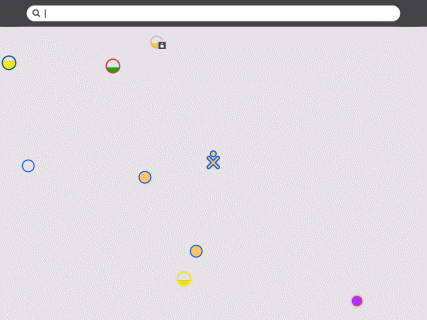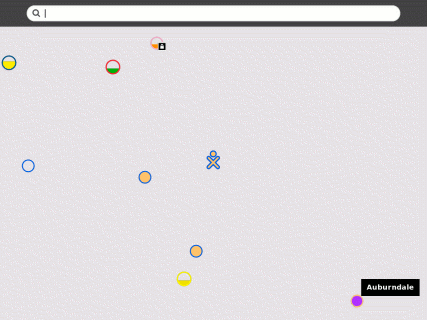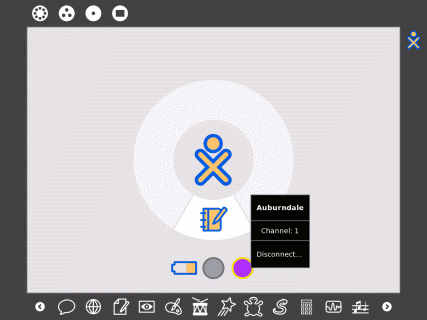Difference between revisions of "Documentation Team/User Manual/Connecting to the Internet/lang-es"
| Line 28: | Line 28: | ||
|display = none}} | |display = none}} | ||
| − | '''Paso 2: Seleccione un | + | '''Paso 2: Seleccione un punto de acceso''' |
{{ Translated text| | {{ Translated text| | ||
| Line 36: | Line 36: | ||
[[Image:Connecting-2.gif]] | [[Image:Connecting-2.gif]] | ||
| + | Su arbol de redes XO (puntos portal) estan representados por circulos del mismo color que su usuario Sugar. Las redes (Puntos de acceso) son representadas por circulos de otros colores. | ||
| + | |||
| + | {{ Translated text| | ||
Your XO's three Mesh Networks (portal point) are represented by circles of the same colors as your Sugar User. Networks (access points) are represented by circles of other colors. | Your XO's three Mesh Networks (portal point) are represented by circles of the same colors as your Sugar User. Networks (access points) are represented by circles of other colors. | ||
| + | display = none}} | ||
| + | Al apuntar a los circulos copn el mouse se abre una ventana que identifica la red: Un punto de acceso es identificado por su nombre (ESSID); un punto portal es identificado por el numero de canal (1, 6 o 11). Tambien puede buscar un punto de acceso por el nombre en la barra de busqueda que esta en la parte superior de la pantalla. | ||
| + | |||
| + | {{ Translated text| | ||
Hovering over a circles opens a pop-pup window that identifies the network: an access point is identified by its name (ESSID); a portal point is identified by its channel number (1, 6, or 11). You can also search for an access point by name in the search bar at the top of the page. | Hovering over a circles opens a pop-pup window that identifies the network: an access point is identified by its name (ESSID); a portal point is identified by its channel number (1, 6, or 11). You can also search for an access point by name in the search bar at the top of the page. | ||
| + | display = none}} | ||
| + | |||
| + | {{ Translated text| | ||
Signal strength is indicated by the fill-level of the circle. Networks that are locked and require a password to use are identified by a small lock symbol at the lower edge of the circle. | Signal strength is indicated by the fill-level of the circle. Networks that are locked and require a password to use are identified by a small lock symbol at the lower edge of the circle. | ||
| − | + | display = none}} | |
Revision as of 01:34, 25 July 2008
Puede hacer su conexion a internet a traves de la vista de Vecindario. Su estado de conexion actual se muestra en la vista hogar. (La XO fue diseNada para acceder por wireless porque en el mundo desarrollado, la wireless es mas rapida, mas confiable y la manera menos costosa de conexion.
Paso 1: Vaya a la vista de Vecindario
Haga click sobre el botos de Vecindario ![]() (Un circulo con 8 puntos), lo encuentra en la esquina superior derecha del teclado, para ir a la vista de Vecindario. Desde aqui puede conectarse a un punto de acceso wifi y ver, si esta conectado a una red mesh o Jabber o si hay otros usuarios Sugar.
(Un circulo con 8 puntos), lo encuentra en la esquina superior derecha del teclado, para ir a la vista de Vecindario. Desde aqui puede conectarse a un punto de acceso wifi y ver, si esta conectado a una red mesh o Jabber o si hay otros usuarios Sugar.
Vera esta pantalla
 .
Su usuario Sugar se representa con el Icono XO, en el centro de la pantalla.
.
Su usuario Sugar se representa con el Icono XO, en el centro de la pantalla.
Paso 2: Seleccione un punto de acceso
Su arbol de redes XO (puntos portal) estan representados por circulos del mismo color que su usuario Sugar. Las redes (Puntos de acceso) son representadas por circulos de otros colores.
Al apuntar a los circulos copn el mouse se abre una ventana que identifica la red: Un punto de acceso es identificado por su nombre (ESSID); un punto portal es identificado por el numero de canal (1, 6 o 11). Tambien puede buscar un punto de acceso por el nombre en la barra de busqueda que esta en la parte superior de la pantalla.
Step 3: Activate a connection
To activate a network or mesh connection, position your mouse inside the circle that corresponds to your chosen access point and click. (To “click”, press once on the left-hand touchpad button—the button with the × symbol at the front of the touchpad.) While the XO is trying to establish the connection, the inside of the circle will blink. Once the connection is established, the outside of the circle will turn white. If for some reason the connection failed, the circle will stop blinking and the outside edge will keep its original color. Sometimes it is necessary to try several times before the connection is established.
If you don't specify a network, Sugar will attempt to join a simple mesh network, enabling you to collaborate with other Sugar users, but not access the Internet.
If the access point requires a key, you will be prompted. Note that different types of access points require different types of keys: be sure to select the correct type from the pull-down menu that is presented.
- Some access points (such as the Apple Extreme®) will only work with a hexadecimal value. If you have a password or passphrase, go to Hex Converter to get the hex key.
- If you are using and Apple Extreme you need to set “shared key”. Most other access points prefer the “open key” setting when using WEP.
Step 4: Checking the connection
Click on the Home symbol ![]() (a circle with a center dot), found in the upper-left corner of the keyboard, to go to the Home view to check your wireless connection.
(a circle with a center dot), found in the upper-left corner of the keyboard, to go to the Home view to check your wireless connection.
By hovering over the circle icon, you will find details about your connection status.
For more information about connecting, please see the Support page in the OLPC wiki.

